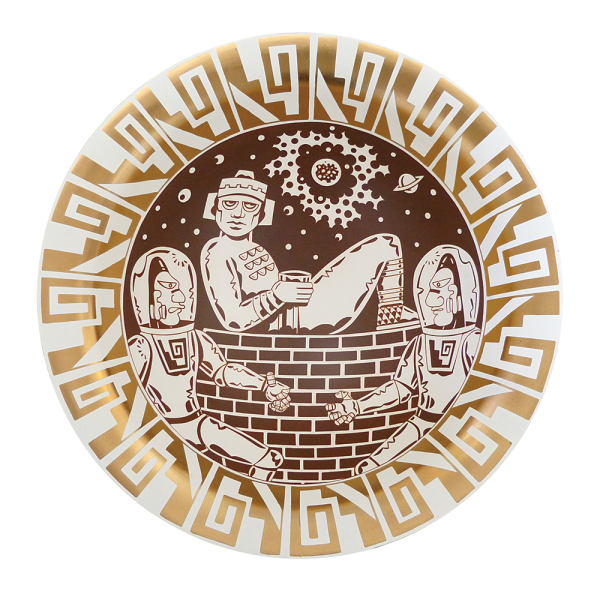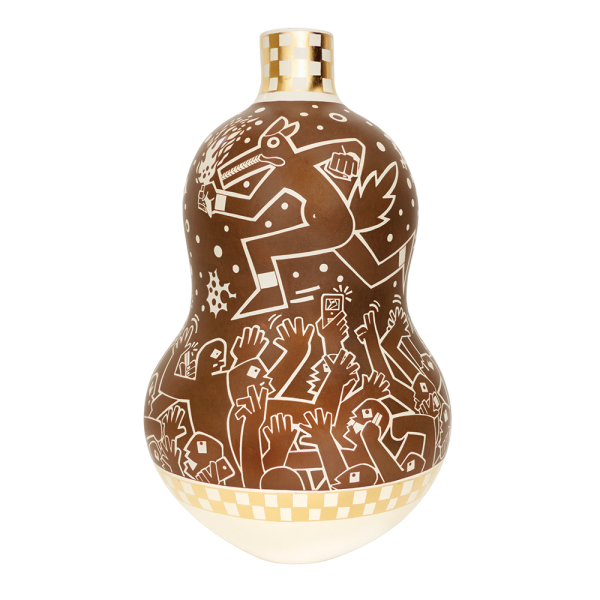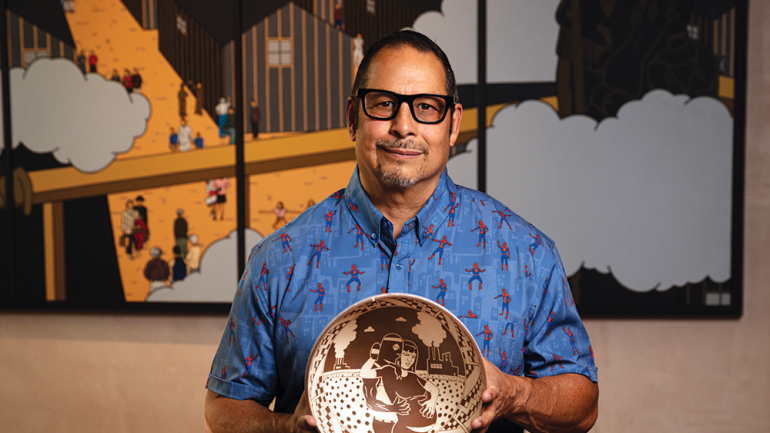Diego Romero
Diego Romero
As a young boy, Diego Romero’s passion for hero narratives was fueled by comic books, The Iliad, The Odyssey, and his father’s stories of daring marines, corsairs, and Vikings. The Cochiti Pueblo artist avidly created superhero drawings and his own comic books until attending the Institute of American Indian Arts in Santa Fe. There, Hopi potter Otellie Loloma grounded Romero with her grandmother wisdom and taught him to dig and mix clay from the earth, hand-coil pots, burnish them with stone, and fire them outside. “It became church,” Romero says. “Since then, pottery has been tied to my spiritual consciousness.”
But his imagination continued to take flight, and his figurative, narrative work transcends his Native American heritage by integrating traditional materials and techniques with well-muscled Greek and Roman figures, self-deprecating humor, pop-culture imagery, and wry social commentary on politics, climate change, racism, colonialism, love, life, and loss. Romero describes himself as “a chronologist on the absurdity of human nature in life,” and loves to watch people crack up laughing when they look at his artwork. The humorous intercultural interplay in Romero’s bowls, vessels, and amphorae also elevate his expert craftsmanship and artistry to, as one critic says, “Olympian stature.”

Chac Mool, a ceramic bowl in memory of Jack Kirby, 6.25 x 16.25 in. Photos courtesy of Shiprock Gallery.

Romero's ceramic vase, Prometheus, 2020, 14.5 x 8.5 in.
Romero studied with Ralph Bacerra at Otis College of Art and Design, earning his BFA, and with Adrian Saxe at UCLA, where he earned his MFA. In the 1990s, Romero’s Chongo Brothers polychrome earthenware series garnered attention in the Southwest ceramics world; the characters represent both Romero and his brother Mateo (a renowned painter) and the mythical Pueblo twin heroes who protect the people.
Romero’s lively and thought-provoking work has been exhibited throughout the US and Europe and is in collections at the Metropolitan Museum of Art, New York; the Fondation Cartier, France; the Peabody Essex Museum, Massachusetts; the Heard Museum, Arizona; the British Museum, London; the National Museum of Scotland, Edinburgh; and the Los Angeles County Museum of Art. “As human beings, our pursuit of enlightenment, spirituality, or superheroism make us better people,” Romero says, adding that his work has evolved to embrace “these universal narratives.”
Read more about the other 2024 ACC Awards recipients and honorees here.
Be part of the celebration
Join us Thursday, September 19 as we celebrate and honor individuals who have dedicated their careers to craft, and who—through their work as artists, educators, mentors, curators, and advocates—have inspired and informed the field.

